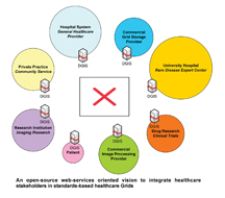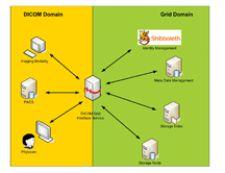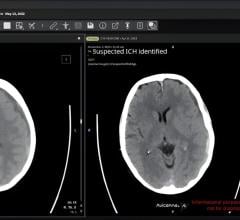
Globus MEDICUS - Transparent communication between DICOM and Grid domains provides instant access to Grid resources of fault-tolerant storage, protected private healthcare information and user identity management and enforcement.
We face a key choice in building healthcare information exchanges (HIE). Do we develop new mechanisms and standards for health-specific data, or do we maximally leverage global open-source Grid initiatives that are currently taking other industries by storm, and modify those for the unique security structures, data models and workflows of healthcare?
Open-Source Software
While several open-source healthcare initiatives exist, addressing various areas of the healthcare IT ecosystem, as of today, healthcare has not embraced the benefits of open-source software. The enabling features of open source – interoperability, security and reduced IT costs – promise to be key benefits for healthcare IT as well, particularly with the focus on healthcare information exchanges (HIE) and in the wake of renewed Federal interest in the nationwide electronic health record (EHR). What’s more, large IT companies such as IBM, Hewlett Packard and Sun Microsystems support the open-source model, leading many industry experts to believe that open-source software will play a key role in moving forward.
Exchange of Medical Images
As U.S. healthcare providers begin exchanging health data across regional healthcare information organizations (RHIO), medical imaging and PACS are drawing more and more attention. If individual PACS could be interconnected, a patient’s prior images would be available anywhere, anytime within the network, yielding improvements in diagnostic and clinical outcomes and eliminating redundant examinations and unnecessary exposure to radiation. The ability to exchange images also holds the promise of optimizing the provision of radiology services in a system suffering from a lack of radiologists and creating efficiency in a healthcare system where redundancy costs billions each year. In research, gaining access to large databases of medical images is also likely to reveal the tremendous, yet untapped potential of data mining.
Thanks to the long-time existence of DICOM as the fully established standard for medical imaging, virtually all diagnostic images are generated under the DICOM format, and nearly half of these images are archived in a digital form. Moreover, PACS vendors are decisively moving away from using proprietary DICOM formats, while older PACS users are undergoing massive data migration projects. Having recognized the clinical benefits of image-enabling the HIE, and seizing the opportunity offered by its technical aspects, Integrating the Healthcare Enterprise (IHE) is in the process of developing the cross-enterprise data sharing for imaging (XDS-I) standards. Medical imaging is therefore at a clear advantage, with respect to other areas, to take the step toward data exchange and interoperation.
In light of such favorable incentives, the key for individual hospitals and healthcare providers, groups of providers, RHIOs and so on, lies in the ability to evaluate and quantify the economic benefits, direct and indirect, of network image-data exchange. Coupled with the cost of deploying the required IT, this assessment can serve to establish a sustainable business model for the implementation and support of the system.
XDS-I and its Challenges
XDS-I (Cross Enterprise Document Sharing - Imaging) depends upon the XDS infrastructure and extends it to handle DICOM-specific communications, data models and fields. This approach faces a number of challenges. It does not inherently provide a mechanism for an individual hospital or provider to join, or more importantly, to associate with more than one virtual organization (VO). The XDS-I does not sufficiently address the key issue of separating the transport/communication standard from the data model standard and from application interfaces.
Fault-tolerance and data replication are two critical features of long-term data storage for PACS, but are not defined in the XDS-I standard. Another current limitation of XDS is that it is not based upon an industry-class security model as is the case for standards within other industries. Instead, it takes the approach of logging the activity in the system and addressing security only after the breach. While this has been an acceptable approach in the healthcare IT systems of yesterday, it is not likely to be acceptable in the future health information infrastructure the Department of Health and Human Services needs. Finally, creating another layer of data-formatting as is the case with XDS-I adds little beyond DICOM itself. One might ask, why not keep the established DICOM standard stable and leverage it by passing its elements in their original form via XML or similar data exchange methods, rather than adding specifications that must then be supported by all players?
The Promise and Flexibility of Grid Technology
The Grid paradigm spawns a Virtual Organization (VO) over public and/or private networks between resource providers (imaging equipment) and consumers (radiologists or imaging researchers). The resources such as images, storage space or post-processing computational power are shared within the VO and protected through industry-level data encryption mechanisms. Providing trusted identity and assertions about users is a key component of Grids. Typically, Grids are built around one or more trust anchors – the Identity Provider (IdP). One such technology is the Internet2 Shibboleth IdP standards-based Security Assertion Markup Language (SAML), a strong contender for becoming the international standard for IdP technology.
Critical to the success of the Grid model is that the underpinning infrastructure must be open-source and standards-based. Vendors, researchers and healthcare providers will not lose with such a model but rather benefit from it as the industry shifts to a global service-based competition with many avenues for creative services.
For example, the PACS market for larger hospitals (400 beds) is well saturated, leaving the smaller hospitals and practices as the only marketplace for new installations. These smaller institutions lack the utilization and staffing power of larger hospitals and are thus more cost-sensitive when it comes to large-scale technology deployment. The Grid can provide a standards-based open-source infrastructure – a middleware - that can be utilized by both healthcare providers and commercial service providers.
Globus MEDICUS — an Open-Source Solution to Inter-Organizational DICOM Data Management
The Globus MEDICUS (Medical Imaging and Computing for Unified Information Sharing) project integrates existing core Globus Toolkit services vertically, allowing for user authentication and authorization, meta-data management, image indexing and data storage in its upcoming release 2. The DICOM Grid Interface Service (Figure 2) of MEDICUS enables transparent, secure and HIPAA-compliant imaging workflows between DICOM devices (imaging modalities, PACS, workstations, etc.) and remote Grid services (storage, management, processing). Store and query/retrieve operations of the DICOM domain are translated into publication and discovery operations of the Grid domain and vice versa. Notably, this means it can be deployed in arbitrarily scalable arrangements without the need for an organization to contract with another in order to add its services to the discoverable ones. MEDICUS benefits from the superior performance of the Grid protocol, designed for large-scale transfers over large geographical areas. Using compressed series packages instead of single-image transfer enhances performance significantly (with a factor of 2 to 10), while preserving the conformance to DICOM of patient-, study-, series- and image-level query/retrieve. The goal of MEDICUS is to integrate existing DICOM legacy devices into Grids without altering the existing DICOM infrastructure. The Grid is seamless to DICOM devices, making operations transparent to the user. As such, MEDICUS can also present itself as a monolithic Enterprise PACS – a Grid PACS.
Within the Grid, images can be shared, discovered and processed. Existing Grid data-replication services can be used to create remote synchronized backups – replicas – to ensure fault tolerance. In case of disasters, recovery comes from these Grid replicas. IdP operations used within the Grid leave an auditable trail of the trusted credentials’ activities, ensuring FDA compliance. Moreover, meta-data containing private healthcare information of the DICOM images are locked in credential-protected Grid databases.
MEDICUS enables hospitals to out-source — “publish” — their images onto the Grid. A Grid could comprise a hospital provider network, participating private practices and university facilities. Deployments can be flexible, such as the federation of multiple hospital PACS systems within a Grid through hospital-initiated push-based image workflows. Images are then stored in the Grid at storage providers with discoverable DICOM meta information. A key feature is that credentials can be validated via other services. Service providers as well as users can subscribe to a credentialing service, thus fully enabling the systems to build up incrementally without startup overhead expenditures in deployment or interorganizational planning — both of which tend to thwart RHIO efforts.
Sociology of Collaborative Environments
Naturally, building an enabling infrastructure alone is insufficient to meet user demands. Social issues such as legal requirements and workflow preferences within each institution and across institutions must be addressed to build workable global health grids. Technology cannot dictate a specific set of policies nor should it, but it can enable flexibility in workflows and enforce policies. What Globus MEDICUS does for DICOM data is enable the execution of virtually any intra- and/or interorganizational data management policy that can be imagined, while providing fault-tolerance and improved performance. In fact, this has already been demonstrated in the clinical research domain with effective image sharing established among more than 40 clinical sites.
The complete article is available online at www.ITNonline.net.



 December 01, 2025
December 01, 2025 









